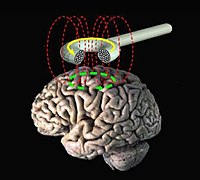
Free‐water and free‐water corrected fractional anisotropy in primary and premotor corticospinal tracts in chronic stroke
Sign Up to like & getrecommendations! Published in 2017 at "Human Brain Mapping"
DOI: 10.1002/hbm.23681
Abstract: Measures from diffusion MRI have been used to characterize the corticospinal tract in chronic stroke. However, diffusivity can be influenced by partial volume effects from free‐water, region of interest placement, and lesion masking. We collected… read more here.
Keywords: free water; water; fractional anisotropy; water corrected ... See more keywords

Predictors of improved aerobic capacity in individuals with chronic stroke participating in cycling interventions.
Sign Up to like & getrecommendations! Published in 2019 at "Archives of physical medicine and rehabilitation"
DOI: 10.1016/j.apmr.2019.10.187
Abstract: OBJECTIVE To determine demographic and physiologic factors that predict improvement in aerobic capacity among individuals with chronic stroke participating in cycling interventions. DESIGN Secondary analysis of data from two randomized clinical trials. SETTING Research laboratory… read more here.
Keywords: individuals chronic; aerobic capacity; chronic stroke; aerobic exercise ... See more keywords

Acute effects of bi-hemispheric transcranial direct current stimulation on the neuromuscular function of patients with chronic stroke: A randomized controlled study.
Sign Up to like & getrecommendations! Published in 2019 at "Clinical biomechanics"
DOI: 10.1016/j.clinbiomech.2019.07.022
Abstract: BACKGROUND Muscle weakness in patients with chronic stroke is due to neuromuscular disorders such as muscle atrophy, loss of voluntary activation or weak muscle contractile properties which are majored by the imbalance of interhemispheric inhibition… read more here.
Keywords: stimulation; current stimulation; patients chronic; chronic stroke ... See more keywords

P069 The prevalence and functional relevance of ipsilateral and contralateral connections to the proximal upper limb in chronic stroke survivors
Sign Up to like & getrecommendations! Published in 2017 at "Clinical Neurophysiology"
DOI: 10.1016/j.clinph.2016.10.194
Abstract: Question After stroke proximal upper limb muscles are innervated not only by contralateral but also by ipsilateral connections. These connections can be probed by transcranial magnetic stimulation (TMS) but whether these connections contribute to the… read more here.
Keywords: limb; stroke survivors; proximal upper; chronic stroke ... See more keywords

O204 Simultaneous bi-hemispheric repetitive transcranial magnetic stimulation for upper limb motor recovery in chronic stroke: A double blind placebo controlled study
Sign Up to like & getrecommendations! Published in 2017 at "Clinical Neurophysiology"
DOI: 10.1016/j.clinph.2017.07.212
Abstract: Objective repetitive transcranial magnetic stimulation (rTMS) is a promising intervention for the treatment of post-stroke motor deficits. Since the crucial role of non-primary motor cortices and contralesional brain areas is emerging for motor recovery in… read more here.
Keywords: stimulation; rtms; repetitive transcranial; motor ... See more keywords

Effects of domotics on cognitive, social and personal functioning in patients with chronic stroke: A pilot study.
Sign Up to like & getrecommendations! Published in 2019 at "Disability and health journal"
DOI: 10.1016/j.dhjo.2019.100838
Abstract: BACKGROUND Stroke can cause severe brain lesions, leading to multiple cognitive, emotional and motor disorders. In fact, it is one of the main causes of death and disability worldwide, with a negative impact on quality… read more here.
Keywords: pilot study; cognitive social; study; effects domotics ... See more keywords

Efficacy of RehaCom cognitive rehabilitation software in activities of daily living, attention and response control in chronic stroke patients
Sign Up to like & getrecommendations! Published in 2020 at "Journal of Clinical Neuroscience"
DOI: 10.1016/j.jocn.2019.08.114
Abstract: BACKGROUND Our world is unfortunately facing a huge number of stroke. Attention, response control and activities of daily living (ADL) are important cognitive functions affected by stroke. In line with this explanation, we aimed to… read more here.
Keywords: attention response; control; stroke patients; response control ... See more keywords

A single session of anodal transcranial direct current stimulation applied over the affected primary motor cortex does not alter gait parameters in chronic stroke survivors
Sign Up to like & getrecommendations! Published in 2019 at "Neurophysiologie Clinique"
DOI: 10.1016/j.neucli.2019.07.012
Abstract: OBJECTIVES The excitability of some neural circuits involved in walking and affected in individuals with chronic stroke can be modulated during and/or immediately after anodal transcranial direct current stimulation (a-tDCS). This study was designed to… read more here.
Keywords: session; gait; chronic stroke; motor cortex ... See more keywords

The effects of repetitive neck-muscle vibration on postural disturbances after a chronic stroke
Sign Up to like & getrecommendations! Published in 2020 at "Neurophysiologie Clinique"
DOI: 10.1016/j.neucli.2020.01.005
Abstract: OBJECTIVE We aimed to test a repeated program of vibration sessions of the neck muscles (rNMV) on postural disturbances and spatial perception in patients with right (RBD) versus left (LBD) vascular brain damage. METHODS Thirty-two… read more here.
Keywords: vibration; rbd; chronic stroke; postural disturbances ... See more keywords

Impact of post-stroke check list in chronic stroke patients management
Sign Up to like & getrecommendations! Published in 2018 at "Annals of Physical and Rehabilitation Medicine"
DOI: 10.1016/j.rehab.2018.05.466
Abstract: Introduction/Background Post-Stroke Checklist (PSCL) is an easy-to-use questionnaire to standardize follow-up care of Chronicpost-stroke patients and facilitate referral to Rehabilitation Services by general practitioners (GPs) in an evidence-based-way. Although it was developed some time ago,… read more here.
Keywords: post stroke; inter consultations; stroke patients; impact post ... See more keywords

Development of a smartphone-based balance assessment system for subjects with chronic stroke
Sign Up to like & getrecommendations! Published in 2018 at "Annals of Physical and Rehabilitation Medicine"
DOI: 10.1016/j.rehab.2018.05.502
Abstract: Introduction/Background Balance is one of the most important issues that chronic stroke sufferers have to deal with. Balance assessment is needed to be taken to know the balance performance. However, assessing balance performance with existed… read more here.
Keywords: smartphone; chronic stroke; subjects chronic; day ... See more keywords